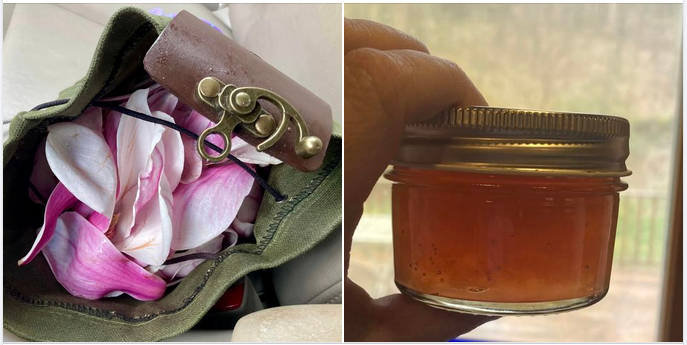It’s Ramp Season! I can tell, because there are ramps up *in my yard.* The creek I live on floods sometimes, and the water running past the front of my house brings with it many things from the woods, ramps included. I hear people say that ramps are so hard to find, and I think “um, not so much,” and then I remember that most people aren’t as blessed as I am. And then I keep my mouth shut.
Identification
Ramps, aka spring onions, ramsons, wild leeks, or Allium tricoccum, is an early spring ephemeral with 2 to 3 broad, smooth, green leaves that grow on burgundy-colored stems. The 5” to 6” leaves smell strongly of onion and garlic, and only last a month or so before wilting and disappearing. Ramps are perennials in the onion family, and grow in groups with their slender onion-like bulbs firmly rooted beneath the soil. They like rich, moist, loose soil high in organic matter and low in pH, which makes shady hardwood forests their perfect habitat. They may appear in small, sparse patches or in dense clusters of multiple acres. Several months after the leaves disappear, flower heads emerge on short straight stalks, blossoming into small white flower clusters that resemble a snowball.
Ramps have two look-alikes, both poisonous: false hellebore and Lily of the Valley, both of which lack the unmistakable ramp scent. False hellebore and ramps like the same growing conditions, but false hellebore leaves are more corrugated or striated. Lily of the Valley has thicker, wavier leaves and no true bulb. If in any doubt, crush a leaf – if it smells like onion or garlic, then you’ve found yourself some ramps.
Harvesting
Step lightly and don’t trample the plants! Some people harvest the whole plant, leaf and bulb. Personally, I only harvest the leaves, one from each plant. This leaves behind the bulb and at least one leaf, guaranteeing more ramps the following year. Early harvesting results in more intense flavor, while late harvests can be bitter. I also harvest the blossoms, taking no more than 1/3 from any ramp patch. I highly recommend wearing tick repellant and conducting a thorough tick check upon returning from any ramp excursion.
Preparing
Wash and refrigerate ramps immediately after harvesting, in a well-sealed container that you’re willing to have smell like ramps forever. If the greens start turning brown, they have passed their “best by” state. For savory jelly making, chop the leaves finely before measuring the amount needed for the herbal infusion. Ramp leaves can be frozen after cleaning for later use, in either glass jars or a double layer of freezer bags; otherwise, they will stink up your freezer, possibly for life.
Uses
Both the leaves and the bulbs of ramps can be used just as you would use onions, green onions, leeks, chives, and garlic. Their flavor is characteristic of a combination of garlic and onion but less intense than either. Cooking makes their taste even mellower and sweeter. The flowers are equally flavorful.
As I mentioned, I’m lucky to have a plethora of ramps in my woods, so I’ve never had to go searching. The foragers I know guard the locations of their ramp caches closely, so if someone ever takes you along ramping, know you are a truly beloved friend.




The very best feature of spring here!